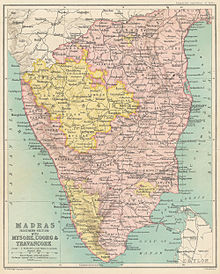Coorg State was a separate State within Union of India from 1950 to 1956 with Mercara as it's Capital
Coorg was earlier a small independent kingdom till 1834, which was annexed by British, as a result of Coorg War and the King of Coorg was deposed.[2][3] Coorg as such in 1834 became a separate province of British India. Upon independence of India, as a legacy, it became a province of Union of India.
Coorg State was formed out of the territory of former Coorg Province, which became a part and parcel of Union of India on 15th August, 1947.
Coorg worked as a Province, till it was created as a Class "C" State, named Coorg State on 26th January, 1950 within Republic of India. Class "C" States were under direct rule of Central Government.[1]
(2) C.T. Mudaliar became Chief Commissioner from 1949 - 1950[1]
(3) Kanwar Daya Singh Bedi, Chief Commissioner from 1950 - 1956[1]
History
Coorg State was formed out of the territory of former Coorg Province, which became a part and parcel of Union of India on 15th August, 1947.
Coorg worked as a Province, till it was created as a Class "C" State, named Coorg State on 26th January, 1950 within Republic of India. Class "C" States were under direct rule of Central Government.[1]
Commissioners of Coorg State
(1) Dewan Bahadur Ketolira Chengappa, became its first Chief Commissioner from 1947 - 1949(2) C.T. Mudaliar became Chief Commissioner from 1949 - 1950[1]
(3) Kanwar Daya Singh Bedi, Chief Commissioner from 1950 - 1956[1]
Chief Minister
Cheppudira Muthana Poonacha was the first and last Chief Minister of Coorg State from 1950 till 1956.[1]Dissolution
In 1956, when India's state boundaries were reorganized, it became a district of the then Mysore State[1][4][5]Mysore State was later renamed as Karnataka, as the historical region of Coorg, now forms the part of Kodagu district of Karnataka.References
- ^ a b c d e f Coorg State : Chief Commissioners
- ^ Phythian-Adams, Lt Col EG. (1943). Madras Infantry 1748-1943. Madras: The Government Press. p. 64-5.
- ^ Ahmad, Maj RN, and Ahmed, Maj Gen Rafiuddin. (2006). Unfaded Glory: The 8th Punjab Regiment 1798-1956. Abbottabad: The Baloch Regimental Centre. pp. 47-8.
- ^ Development of Mysore state, 1940-56 by M. B. Gayathri
- ^ Karnataka government and politics By Harish Ramaswamy, S. S. Patagundi, Shankaragouda Hanamantagouda Patil

This work is licensed under a Creative Commons Attribution-NonCommercial-NoDerivs 2.5 India License.




